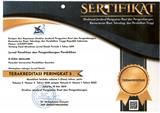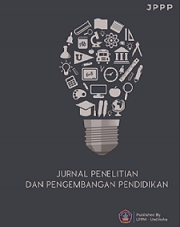Speech Development Pattern Strategy in Indonesian Language Teaching Practices by PPG Students Daljab PGRI
DOI:
https://doi.org/10.23887/jppp.v8i2.73972Keywords:
Speech Development Pattern Strategy, Explaining Skills, PPG StudentsAbstract
The teacher acts as the main communicator in the classroom, using spoken language to convey material, motivate students, and create a conducive learning environment. However, many teachers, especially Indonesian language teachers, still need to fully understand the importance of skills in learning, resulting in their speaking skills being low. This study aims to analyze the strategies of speech development patterns as well as the reasons and purposes of their application in Indonesian language teaching practice by PPG Daljab K1 students. This research is classified into case study research. The data source is in the form of learning videos uploaded to each PPG Daljab student's YouTube account, totaling 36 data. Data collection is done using observation and interview methods. The instrument used is an interview sheet. After the data was collected, it was analyzed through several stages, including three stages, namely data reduction, data presentation, and conclusion drawing or verification. The main results of this study show that PPG Daljab students use various strategies of speech development patterns, such as deductive, inductive, causal, logical, direct comparison, basic techniques of explanation before or after the statement, analogy, narration, and climax, in the practice of teaching Indonesian. This study concludes that the use of this strategy creates an effective learning situation, allowing students to develop mental and intellectual activities to the fullest. The implication of this study suggests the importance of integrating this strategy into the educational curriculum to improve the effectiveness of Indonesian language learning at the PPG Daljab level.
References
Adnyana, K. S. (2023). Penilaian Bahasa Indonesia Dalam Kurikulum Merdeka. Stilistika : Jurnal Pendidikan Bahasa Dan Seni, 11(2), 343–359. https://doi.org/10.59672/stilistika.v11i2.2849. DOI: https://doi.org/10.59672/stilistika.v11i2.2849
Arifin, S., Yahya, M., & Siddik, M. (2019). Strategi Komunikasi Siswa Dan Guru Kelas XI SMAN 2 Sangatta Utara Dalam Proses Pembelajaran Bahasa Indonesia. Diglosia: Jurnal Kajian Bahasa, Sastra, Dan Pengajarannya, 2(1), 15–38. https://doi.org/10.30872/diglosia.v2i1.15. DOI: https://doi.org/10.30872/diglosia.v2i1.15
Arnawa, N., Karpika, I. P., Wijaya, I. M. G. P., Astawan, N., & Agung Ekasriadi, I. A. (2023). Functional Pragmatic Analysis on the Humorous Discourse in Balinese Language as a Media of Socialization of Health Protocols during the Covid-19 Pandemic. English Language Teaching and Linguistics Studies, 5(1), p33. https://doi.org/10.22158/eltls.v5n1p33. DOI: https://doi.org/10.22158/eltls.v5n1p33
Ataboyev, I. M., & Turgunova, F. R. (2022). The concept of semantic field in linguistics. ACADEMICIA: An International Multidisciplinary Research Journal, 12(3), 319–324. https://doi.org/10.5958/2249. DOI: https://doi.org/10.5958/2249-7137.2022.00223.3
Atmazaki, A., Ramadhan, S., Indriyani, V., & Nabila, J. (2021). Dialogic-interactive media: Alternative learning media to improve speaking skills. KEMBARA Journal of Scientific Language Literature and Teaching, 7(2), 286–296. https://doi.org/10.22219/kembara.v7i2.16402. DOI: https://doi.org/10.22219/kembara.v7i2.16402
Bormann, E & Bormann, N. (1991). Retorika. Terjemahan Paulus Sulasdi. Rhetoric.
Dewantara, I. P. M. (2020). Curriculum changes in Indonesia: Teacher constraints and students of prospective teachers’ readiness in the implementation of thematic learning at low grade primary school. Elementary Education Online, 19(2), 1047–1060. https://doi.org/10.17051/ilkonline.2020. DOI: https://doi.org/10.17051/ilkonline.2020.696686
Dewantara, I. P. M., Suandi, I. N., Rasna, I. W., & Putrayasa, I. B. (2019). Cultivating students’ interest and positive attitudes towards Indonesian language through phenomenon-text-based information literacy learning. International Journal of Instruction, 12(2), 147–162. https://doi.org/10.29333/iji.2019. DOI: https://doi.org/10.29333/iji.2019.12210a
Diani, I., Arono, & Yunita, W. (2022). A Pragmatics Study on Verbal Abuse Against Women and Children by Bengkulu Communities on Social-Media, at Schools, and in Families. Kembara: Jurnal Keilmuan Bahasa, Sastra, Dan Pengajarannya, 8(2), 391–406. DOI: https://doi.org/10.22219/kembara.v8i2.21900
Fitri, S., & Saleh, M. (2023). the Influence of Speaking Skills Teaching Materials on Students’ Language Politeness Based on the Mother Tongue. RETORIKA: Jurnal Bahasa, Sastra, Dan Pengajarannya, 16(1), 26–34. https://doi.org/10.26858/retorika.v16i1.46582. DOI: https://doi.org/10.26858/retorika.v16i1.46582
Haslinda, H. (2022). Tindak Tutur Ekspresif Dalam Pembelajaran Bahasa Indonesia. Jurnal Panrita, 2(2), 80–90. https://doi.org/10.35906/panrita.v2i2.178. DOI: https://doi.org/10.35906/panrita.v2i2.178
Hasriani, H., Aeni, N., & Suwarni, A. (2023). Inserting Read, Encode, Annotate and Ponder (Reap) Strategy To Enhance Students’ Reading Comprehension. RETORIKA: Jurnal Bahasa, Sastra, Dan Pengajarannya, 16(1), 9–16. https://doi.org/10.26858/retorika.v16i1.43494. DOI: https://doi.org/10.26858/retorika.v16i1.43494
Hsbollah, H. M., & Hassan, H. (2022). Creating Meaningful Learning Experiences With Active , Fun , And Technology Elements In The Problem-Based Learning Approach Hafizah Mohamad Hsbollah & 2 Haslinda Hassan Tunku Puteri Intan Safinaz School of Accountancy ,. Malaysian Journal of Learning and Instruction, 19(1), 147–181. https://doi.org/10.32890/mjli2022.19.1.6. DOI: https://doi.org/10.32890/mjli2022.19.1.6
Hudaa, S. (2018). Efektifitas Pembelajaran Bahasa Indonesia Menggunakan Pendekatan Student Active Learning Di Jurusan Manajemen Fakultas Ekonomi Dan Bisnis Uin Syarif Hidayatullah Jakarta. Bahastra, 38(1), 69. https://doi.org/10.26555/bahastra.v38i1.7300. DOI: https://doi.org/10.26555/bahastra.v38i1.7300
Ilmiah, J., & Pendidikan, W. (2023). 3 1,2,3. 9(5), 546–552.
Indrayani, I. I. (2022). Retorika dan Power Relations: Strategi Restorasi Citra Kepolisian Republik Indonesia pada Kasus Ferdy Sambo. Jurnal Komunikatif, 11(2), 165–178. https://doi.org/10.33508/jk.v1. DOI: https://doi.org/10.33508/jk.v11i2.4270
Kadek, I., Dwipayana, A., Astawan, N., Ayu, I., Ekasriadi, A., Sadwika, N., & De Liska, L. (2023). The International Journal of Social Sciences World Hegemonic Ideology and Symbolic Violence of Balinese Language in The Marriage Tradition: A Gender Perspective. The International Journal of Social Sciences World TIJOSSW, 5(1), 161–171.
Karataş, T. Ö., & Tuncer, H. (2020). Sustaining language skills development of pre-service EFL teachers despite the COVID-19 interruption: A case of emergency distance education. Sustainability (Switzerland), 12(19). https://doi.org/10.3390/su12198188. DOI: https://doi.org/10.3390/su12198188
Keraf, G. (2009). Diksi dan Gaya Bahasa.
Leaker, C., & Ostman, H. (2009). Composing knowledge:Writing, rhetoric, and reflection in prior learning assessment. College Composition and Communication, 61(4), 691–717. DOI: https://doi.org/10.58680/ccc201011335
Leech, G. N. (2014). The pragmatics of politeness. DOI: https://doi.org/10.1093/acprof:oso/9780195341386.001.0001
Ma’rufah, D. W. (2021). Promoting Student Questioning in EFL Classroom: Teacher’s Strategies in 2013 Curriculum Context. OKARA: Jurnal Bahasa Dan Sastra, 15(2), 170–184. https://doi.org/10.19105/ojbs.v15i2.4284. DOI: https://doi.org/10.19105/ojbs.v15i2.4284
Mardiana, D., Rokhman, F., Rustono, R., & Mardikantoro, H. B. (2021). Penguasaan Retorik Interpersonal Sebagai Strategi Kompetensi Komunikatif Guru Kelas dalam Pembelajaran Bahasa di Pendidikan Abad 21. Prosiding Seminar Nasional Pascasarjana (PROSNAMPAS), 4(1), 348–354. DOI: https://doi.org/10.33084/tunas.v6i2.2519
Milles, M. (1992). Analisis Data Kualitatif. Terjemahan Tjetjep Rohendi Rohidi.
Mujianto, G. (2016). Karakteristik Tuturan Performatif Guru dalam Pembelajaran Bahasa Indonesia Berdasarkan Pendekatan Saintifik. KEMBARA: (Jurnal Keilmuan Bahasa, Sastra, Dan Pengajarannya), 2(2), 172–186.
Mulyati, Y. F., Hidayat, D. N., Husna, N., Alek, A., & Baker, S. (2023). Conversational Analysis on Politeness in Online Class Discussions: Exploring Turn-Taking and Relational Work Strategies Between Lecturer and Students. OKARA: Jurnal Bahasa Dan Sastra, 17(1), 102–117. https://doi.org/10.19105/ojbs.v17i1. DOI: https://doi.org/10.19105/ojbs.v17i1.8079
Nayum, N.-, Nursaly, B. R., & Padlurrohman, P. (2022). TEACHER’S RHETHORIC IN LEARNING REVIEWED FROM VARIETY OF SPEECH IN Mts MUALLIMAT NWDI. SeBaSa, 5(1), 24–33. https://doi.org/10.29408/sbs.v5i1.5532. DOI: https://doi.org/10.29408/sbs.v5i1.5532
Onishchuk, I., Ikonnikova, M., Antonenko, T., Kharchenko, I., Shestakova, S., Kuzmenko, N., & Maksymchuk, B. (2020). Characteristics of Foreign Language Education in Foreign Countries and Ways of Applying Foreign Experience in Pedagogical Universities of Ukraine. Revista Romaneasca Pentru Educatie Multidimensionala, 12(3), 44–65. https://doi.org/10.18662/rrem/12.3/308. DOI: https://doi.org/10.18662/rrem/12.3/308
Pramujiono, A., Suhari, Rachmadtullah, R., Indrayanti, T., Setiawan, B., & Pujiastuti, R. (2020). Kesantunan Berbahasa, Pendidikan Karater, Dan Pembelajaran Yang Humanis (R. Pujiastuti (ed.)). Indocamp. https://books.google.co.id/books?id=L5EmEAAAQBAJ.
Pramujiono, A., Suhari, S., Indrayanti, T., & Rochmawati, D. (2019). Recounting As Realization of Brown and Levinson’S Positive Politeness Strategies in Instructional Interactions. KEMBARA Journal of Scientific Language Literature and Teaching, 5(2), 137. https://doi.org/10.22219/kembara.vol5. DOI: https://doi.org/10.22219/kembara.v5i2.9996
Putrayasa, I. B. (2017). Literature as Media Education Nation Character Values. International Journal of Linguistics, Literature, and Culture, 3(3), 1–9. https://doi.org/10.21744/ijllc.v3i3.443. DOI: https://doi.org/10.21744/ijllc.v3i3.443
Rahardi, K. (2017). Linguistic Impoliteness in The Sociopragmatic Perspective. Jurnal Humaniora, 29(3), 309. https://doi.org/10.22146/jh.v29i3.24954. DOI: https://doi.org/10.22146/jh.v29i3.24954
Rahmah, S., & Mujianto, G. (2023). Analisis penggunaan bahasa resmi pada struktur percakapan dalam pembelajaran bahasa Indonesia di MAN 2 Ngawi (Analysis of the use of official language in conversational structure in Indonesian learning in MAN 2 Ngawi). KEMBARA: Jurnal Keilmuan Bahasa, Sastra, Dan Pengajarannya, 9(1), 147–162. DOI: https://doi.org/10.22219/kembara.v9i1.22275
Sasmaya, F. D. D. D., Suyitno, I., & Sunoto, S. (2019). Fungsi Tuturan Motivatif Guru dalam Pembelajaran di SMA. Jurnal Pendidikan: Teori, Penelitian, Dan Pengembangan, 4(1), 13. https://doi.org/10.17977/jptpp.v4i1.11839. DOI: https://doi.org/10.17977/jptpp.v4i1.11839
Sudiana, I. N. (2007). Retorika (Bertutur Efektif).
Sugiyono. (2012). Penelitian Pendidikan: Pendekatan Kuantitatif, Kualitatif, dan R&D.
Syahputra, A. A. (2022). Analisis Filsafat: Retorika Aristoteles dalam Meningkatkan Kemapuan Public Speaking dan Relevansinya Pembelajaran. JIM: Jurnal Ilmiah Mahasiswa Pendidikan Sejarah, 7(1), 15–25. https://doi.org/10.24815/jimps.v7i1.16162. DOI: https://doi.org/10.24815/jimps.v7i1.16162
Talan, M. R. (2019). Struktur Percakapan Guru dengan Siswa dalam Interaksi Pembelajaran Bahasa Indonesia. Jubindo: Jurnal Ilmu Pendidikan Bahasa Dan Sastra Indonesia, 4(2), 77–84. https://doi.org/10.32938/jbi.v4i2.134. DOI: https://doi.org/10.32938/jbi.v4i2.134
Widiasri, D. A. (2023). Application of Ethno-Pragmatic Learning Strategies in Indonesian Language Lessons in High School in the Merdeka Curriculum (Penerapan Strategi Pembelajaran Ethno-Pragmatik Pada Pelajaran Bahasa Indonesia Di Sma Pada Kurikulum Merdeka). Gramatika STKIP PGRI Sumatera Barat, 9(1), 143–158. https://doi.org/10.22202/jg.2023.v9i1.6730. DOI: https://doi.org/10.22202/jg.2023.v9i1.6730
Wirahyuni, K., Suandi, I. N., Martha, I. N., & Sudiana, I. N. (2021). Validity and Reliability of a Digital-based Affective Evaluation Instrument on Indonesian MPK Learning at Ganesha University of Education. International Journal of Early Childhood Special Education, 13(2), 1138–1145. https://doi.org/10.9756/INT-JECSE/V13I2.211159. DOI: https://doi.org/10.9756/INT-JECSE/V13I2.211159
Wulandari, A. L. (2018). Strategi Retorika Verbal dan Nonverbal Karni Ilyas dalam Acara Indonesia Lawyers Club. Transformatika: Jurnal Bahasa, Sastra, Dan Pengajarannya, 2(2), 140. https://doi.org/10.31002/transformatika.v2i2.877. DOI: https://doi.org/10.31002/transformatika.v2i2.877
Yulika, N. L. E. C., Budiarta, I. W., & Susanthi, I. G. A. A. D. (2022). Analisis Makna, Pesan, dan Retorika dalam Iklan Kitabisa.com. Kembara: Jurnal Keilmuan Bahasa, Sastra, Dan Pengajarannya, 8(2), 472–491. DOI: https://doi.org/10.22219/kembara.v8i2.21340
Downloads
Published
How to Cite
Issue
Section
License
Copyright (c) 2024 Ekasriadi, I Kadek Adhi Dwipayana; Ni Luh Gede Liswahyuningsih

This work is licensed under a Creative Commons Attribution-ShareAlike 4.0 International License.
Authors who publish with the Jurnal Penelitian dan Pengembangan Pendidikan agree to the following terms:
- Authors retain copyright and grant the journal the right of first publication with the work simultaneously licensed under a Creative Commons Attribution License (CC BY-SA 4.0) that allows others to share the work with an acknowledgment of the work's authorship and initial publication in this journal.
- Authors are able to enter into separate, additional contractual arrangements for the non-exclusive distribution of the journal's published version of the work (e.g., post it to an institutional repository or publish it in a book), with an acknowledgment of its initial publication in this journal.
- Authors are permitted and encouraged to post their work online (e.g., in institutional repositories or on their website) prior to and during the submission process, as it can lead to productive exchanges, as well as earlier and greater citation of published work. (See The Effect of Open Access)







